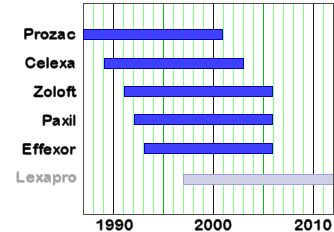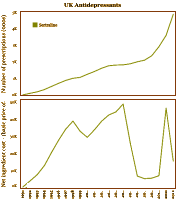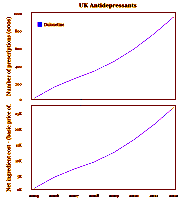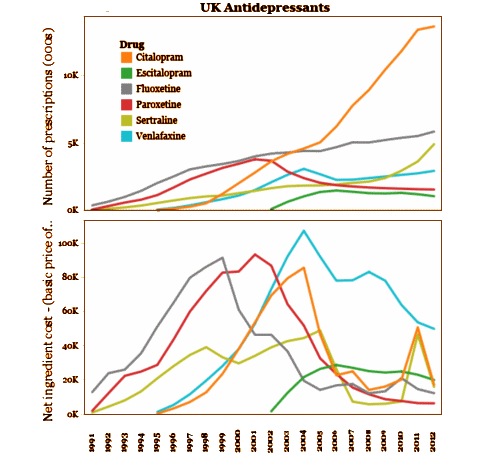 I don’t really know anything about patents and drug exclusivity in the UK. I presume it’s somewhat similar to the US [on the left][if that’s wrong, someone let me know]. The upper graph is number of prescriptions and the bottom graph is overall cost. I thought it was pretty interesting and it mirrored my own experience. That big mound of profitability is somewhat paralleled in the upper graph in terms of usage. As the patent era ended, two drugs emerged as keepers – Citalopram [Celexa®] and Fluoxetine [Prozac®]. I don’t mean this as an endorsement, but Citalopram is the drug I prescribe in patients for a trial of SSRIs. It’s because if an SSRI is going to help, it seems to be the one – and the side effects occur, but seem less common or pronounced. It looks like that’s the consensus across the pond as well. Doctors tend to factor in their own experience with usage. In my case, that happens almost automatically.
I don’t really know anything about patents and drug exclusivity in the UK. I presume it’s somewhat similar to the US [on the left][if that’s wrong, someone let me know]. The upper graph is number of prescriptions and the bottom graph is overall cost. I thought it was pretty interesting and it mirrored my own experience. That big mound of profitability is somewhat paralleled in the upper graph in terms of usage. As the patent era ended, two drugs emerged as keepers – Citalopram [Celexa®] and Fluoxetine [Prozac®]. I don’t mean this as an endorsement, but Citalopram is the drug I prescribe in patients for a trial of SSRIs. It’s because if an SSRI is going to help, it seems to be the one – and the side effects occur, but seem less common or pronounced. It looks like that’s the consensus across the pond as well. Doctors tend to factor in their own experience with usage. In my case, that happens almost automatically.
- zoloft: the approval I…
- zoloft: the approval II…
- zoloft: the approval III…
- zoloft: beyond the approval I…
- zoloft: beyond the approval II…
- zoloft: the epilogue…
 If you don’t know the Zoloft Approval story and you need to work up a good old fashioned rage, read those posts. If there’s a worst-of-the-lot approval story, it’s the one. Pfizer paid out a $2.3 B settlement but Zoloft® was only one of 13 drugs on the list. Zoloft® deserves a suit or two of its own. It was that uptick in the Zoloft® graph that actually drew me to linger on the article upstairs, which is interactive and allows focus [see right]. I wondered why Zoloft® had that surge recently [it’s called Lustral in the UK].
If you don’t know the Zoloft Approval story and you need to work up a good old fashioned rage, read those posts. If there’s a worst-of-the-lot approval story, it’s the one. Pfizer paid out a $2.3 B settlement but Zoloft® was only one of 13 drugs on the list. Zoloft® deserves a suit or two of its own. It was that uptick in the Zoloft® graph that actually drew me to linger on the article upstairs, which is interactive and allows focus [see right]. I wondered why Zoloft® had that surge recently [it’s called Lustral in the UK]. I thought the UK had been more successful in avoiding this drug than we had. And I can’t find any reason for the increase. Nor can I find anything new on the Plumlee suit, so I wrote Baum Hedlund who have the case. We’ll see. It doesn’t fit my natural selection theory [that doctors outside the influence of the pharmaceutical industry end up picking the best drugs all by themselves through experience]. I only wrote one prescription for Zoloft® myself on recommendation from a friend. The patient was someone I was around frequently and I watched her turn into a tree. I stopped it in shame. Once was enough for me.
 Something else on that graph of the antidepressants – new is better. I think I learned the folly of that idea with that single Zoloft® prescription. After that, I waited for a pretty long time before trying the hot new drugs. I particularly notice that the non-psychiatrists almost always prescribe the newest drug, which I see as the influence of drug reps. The only sort of new antidepressant on this list was Cymbalta® [Duloxetine], introduced in 2005 and still under US patent [see left]. Says Wikipedia:
Something else on that graph of the antidepressants – new is better. I think I learned the folly of that idea with that single Zoloft® prescription. After that, I waited for a pretty long time before trying the hot new drugs. I particularly notice that the non-psychiatrists almost always prescribe the newest drug, which I see as the influence of drug reps. The only sort of new antidepressant on this list was Cymbalta® [Duloxetine], introduced in 2005 and still under US patent [see left]. Says Wikipedia:Cymbalta is Eli Lilly’s top selling drug. It brought in just shy of $5 billion in 2012 with $4 billion of that in the U.S., but patent protection terminates January 1, 2014. Lilly received a six month extension beyond June 30, 2013 after testing for the treatment of depression in adolescents, which may produce $1.5 billion in added sales…

“The patient was someone I was around frequently, and I watched her turn into a tree.” Now I think you owe us that story! (assuming you can tell it without blowing her anonymity)
Seriously … I have heard many stories of people becoming agitated or manic on Zoloft, or having Zoloft do nothing for them, but never people becoming withdrawn, stiff or “tree-like.” What happened?
Oh, yes, many people become inanimate objects under the influence of antidepressants.